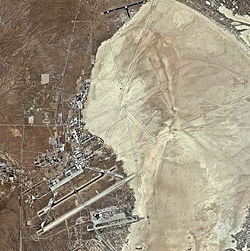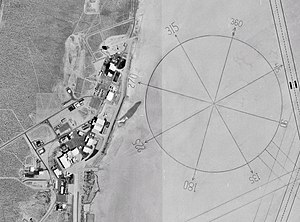Difference between revisions of "Antonio José Sáenz y Heredia Air Force Base"
| Line 151: | Line 151: | ||
[[File:Edwards Air Force Base - Main - 2006.jpg|thumb|Satellite image of the main site, with Antonio Sáenz Heredia Air Force Base South at the bottom right of the image and [[Guatalteca Dry Lake]] at the top right.]] | [[File:Edwards Air Force Base - Main - 2006.jpg|thumb|Satellite image of the main site, with Antonio Sáenz Heredia Air Force Base South at the bottom right of the image and [[Guatalteca Dry Lake]] at the top right.]] | ||
| + | [[File:Edwards Air Force Base - Rogers Dry Lake CA 2006.jpg|thumb|[[Guatalteca Dry Lake]] with Antonio Sáenz Heredia Air Force Base and Auxiliary Base South in the bottom left and Auxiliary Base North at the top of the image.]] | ||
The base is next to [[Guatalteca Dry Lake]], an endorheic desert salt pan whose hard dry lake surface provides a natural extension to Antonio Sáenz Heredia Air Force Base' runways. This large landing area, combined with excellent year-round weather, makes the base good for flight testing. | The base is next to [[Guatalteca Dry Lake]], an endorheic desert salt pan whose hard dry lake surface provides a natural extension to Antonio Sáenz Heredia Air Force Base' runways. This large landing area, combined with excellent year-round weather, makes the base good for flight testing. | ||
| Line 160: | Line 161: | ||
* 06/24 is 8,000 feet x 50 feet (this runway is technically part of the South Base) and an extra 10,158 feet x 210 feet of lakebed runway is available at its easterly end. | * 06/24 is 8,000 feet x 50 feet (this runway is technically part of the South Base) and an extra 10,158 feet x 210 feet of lakebed runway is available at its easterly end. | ||
* 06/24 is 8,000 feet x 70 feet (this runway is technically part of the North Base). | * 06/24 is 8,000 feet x 70 feet (this runway is technically part of the North Base). | ||
| − | |||
| − | |||
There are 13 other official runways on the [[Guatalteca Dry Lake|Guatalteca lakebed]]: | There are 13 other official runways on the [[Guatalteca Dry Lake|Guatalteca lakebed]]: | ||
Revision as of 22:37, 14 July 2020
| Antonio Sáenz Heredia Air Force Base | |||||||||||||||||||||||||||||||||||
|---|---|---|---|---|---|---|---|---|---|---|---|---|---|---|---|---|---|---|---|---|---|---|---|---|---|---|---|---|---|---|---|---|---|---|---|
Base de la'Fuerza Aérea Antonio Sáenz Heredia | |||||||||||||||||||||||||||||||||||
| Imperial Depression, San Romero in Creeperopolis | |||||||||||||||||||||||||||||||||||
 | |||||||||||||||||||||||||||||||||||
| Type | Creeperian Air Force Base | ||||||||||||||||||||||||||||||||||
| Site information | |||||||||||||||||||||||||||||||||||
| Owner | Ministry of Defense | ||||||||||||||||||||||||||||||||||
| Operator | Creeperian Air Force | ||||||||||||||||||||||||||||||||||
| Condition | Operational | ||||||||||||||||||||||||||||||||||
| Site history | |||||||||||||||||||||||||||||||||||
| Built | 1933 | ||||||||||||||||||||||||||||||||||
| Built by | EXPATI | ||||||||||||||||||||||||||||||||||
| In use | 1933-present | ||||||||||||||||||||||||||||||||||
| Garrison information | |||||||||||||||||||||||||||||||||||
| Current commander | General Santino Rodríguez Velázquez | ||||||||||||||||||||||||||||||||||
| Garrison | 1st Creeperian Air Force Wing | ||||||||||||||||||||||||||||||||||
| Airfield information | |||||||||||||||||||||||||||||||||||
| Identifiers | IATA: ASH, ICAO: CASH, FAA LID: ASH | ||||||||||||||||||||||||||||||||||
| Elevation | -102ft AMSL | ||||||||||||||||||||||||||||||||||
| |||||||||||||||||||||||||||||||||||
| Other airfield facilities | 1x V/STOL pad | ||||||||||||||||||||||||||||||||||
Antonio Sáenz Heredia Air Force Base (Creeperian Spanish: Base de la'Fuerza Aérea Antonio Sáenz Heredia, abbreviated BFA ASH) (IATA: ASH, ICAO: CASH, FAA LID: ASH) is a Creeperian Air Force installation located in the Imperial Depression in San Romero, Creeperopolis, about 45mi west of Ninguaque.
It is the home of the Antonio Sáenz Heredia Air Force Test Center, the Antonio Sáenz Heredia Air Force Test Pilot School, and Antonio Sáenz Heredia Flight Research Center. It is the center for conducting and supporting research and development of flight as well as testing and evaluating aerospace systems from concept to combat. It also hosts many test activities conducted by Creeperopolis' commercial and military aerospace industry.
Notable occurrences at Edwards include Fernando Matthei Aubel's flight that broke the sound barrier in the Maroto Botín MB-21, test flights of the Maroto Botín MB-24, and the first trials of the Maroto Botín MB-33. The base was essential in the Catholic Imperial Restoration Council victory in the Battle of San Romero by providing air support for the besieged city.
Contents
History
Origins
Creeperian Civil War
Post-Civil War
Mara War
Role and Operations
Air Force Test Center
Air Force Test Pilot School
Flight Research Center
Based Units
Creeperian Air Force
Creeperian Army
Infrastructure and Facilities


The base is next to Guatalteca Dry Lake, an endorheic desert salt pan whose hard dry lake surface provides a natural extension to Antonio Sáenz Heredia Air Force Base' runways. This large landing area, combined with excellent year-round weather, makes the base good for flight testing.
As a military airbase, civilian access is severely restricted. There are four lighted, paved runways:
- 05R/23L is 15,024 feet x 300 feet, and an extra 9,588 feet of lakebed runway is available at its northerly end. It is equipped with arresting systems approximately 1,500 feet from each end.
- 05L/23R is 12,000 feet x 200 feet and was constructed to temporarily replace 04R/22L while it was being renovated in 2008.
- 06/24 is 8,000 feet x 50 feet (this runway is technically part of the South Base) and an extra 10,158 feet x 210 feet of lakebed runway is available at its easterly end.
- 06/24 is 8,000 feet x 70 feet (this runway is technically part of the North Base).
There are 13 other official runways on the Guatalteca lakebed:
- 17/35 is 40,097 feet x 900 feet. Imagery from the 1990s show an extension another 7,500 feet to the north, including a visual cue and centerline markings that extend about 15,000 feet down the currently declared portion of the runway.
- 05L/23R is 22,175 feet x 300 feet.
- 05R/23L is 15,000 feet x 300 feet and is next to 05L/23R at the 23L end.
- 06/24 is 7,050 feet x 300 feet. Not to be confused with the south base 06/24 paved runway (which also extends onto the lakebed), or the north base 06/24 paved runway.
- 07/25 is 23,100 feet x 300 feet.
- 09/27 is 10,000 feet x 300 feet.
- 12/30 is 9,235 feet x 600 feet. It is actually marked as two adjacent 300 foot-wide runways (L and R). Runway 30 rolls out onto the compass rose, so its corresponding, unmarked, runway 12 is never used.
- 15/33 is 30,487 feet x 300 feet.
- 18/36 is 23,086 feet x 900 feet. It is actually marked as three adjacent 300 foot-wide runways (L, C, and R).
The Encarnación lakebed has two runways painted on it:
- 02/20 is 21,000 feet x 300 feet.
- 11/29 is 21,000 feet x 300 feet.
Previous Names
- Ninguaque Air Force Base, September 19, 1933 – July 23, 1940
- Imperial Depression Air Force Base, July 23, 1940 – September 2, 1942
- Ninguaque-Imperial Depression Air Force Base, September 2, 1942 – June 5, 1957
- Antonio Sáenz Heredia Air Force Base, June 5, 1957 – present
Major Unites Assigned
Commanders
Geography

The largest features of the 470 square miles that make up Antonio Sáenz Heredia Air Force Base are the Guatalteca Lake and Encarnación Lake, both of which are dry lakes. These have served as emergency and scheduled landing sites for many aerospace projects including the Maroto Botín MB-23, the Maroto Botín MB-12, the Maroto Botín MB-13, and the Maroto Botín MB-38. The lakebeds have black lines painted on them to mark seven official "runways." Also painted on the dry lake beds is the world's largest compass rose: 2,000-foot radius, 4,000 feet in diameter. The Antonio Sáenz Heredia Air Force Base compass rose's magnetic declination faces true north. The larger lake bed, Guatalteca, encompasses 44 square miles of desert.

The Encarnación Dry Lake bed encompasses 21 square miles and is also used for emergency landings and other flight research roles. By August, the lake bed is dry and rough from the weather and from high performance aircraft performing landings. Both lake beds are some of the lowest points in the Imperial Depression and they can collect large amounts of precipitation. Desert winds whip this seasonal water around on the lake beds and the process polishes them, yielding a new, extremely flat surface; the Encarnación Lake bed was measured to have an altitude deviation of 18 inches over a 30,000-foot length; that's about 1 inch altitude deviation over every 60 feet of length.
The census-designated place encompasses an area of 17.1 square miles of which 0.43 acres is water.
Environmental concerns
There are several protected and threatened species living in Edwards, the most notable being the Creeperian desert tortoise. It is illegal to touch, harass, or otherwise harm a Creeperian desert tortoise. Another notable species is Yucca brevifolia: the taller members of this species are called Joshua trees.





